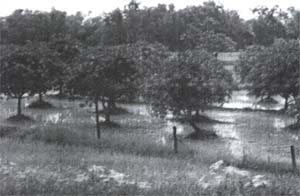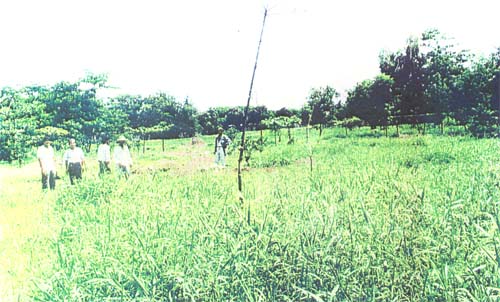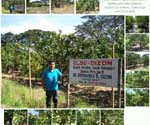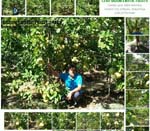|
|
|
Agriculture Magazine, February
2003 |
|
How to grow fruit trees on low-lying fields The trick is to
grow them in mounds about two feet about the ground level |
|
by Jennifer G. Berioso |
|
|
 |
|
Mango tree planted on
mounds of soil in a low-lying field |
|
You can increase your income from your rice field by
converting in into an orchard. A number of people
have done just that, usually planting mango trees.
Some are successful, some are not.
One farmer in Bulacan is not so lucky. He planted
his favorite grafted mango seedlings in his rice
field that has not been giving him a decent harvest.
The trouble is that the trees are already eight
years old but they are no bigger than five feet
tall. While they should be fruiting commercially by
now, only few are just bearing a few fruits each. |
|
The main problem is waterlogging. The mango trees are not growing as
they should because their roots are submerged, particularly
during the rainy season. When the soil is waterlogged, the
root hairs which absorb oxygen needed for plant growth are
impaired. Hence, the plants get stunted, or at worst they
die.
There's a way, however, to succeed in growing mango
trees even in waterlogged fields. The trick is to provide
sufficient drainage so that the root hairs don't get
"drowned". How do you achieve that in a rice field that is
often flooded during the rainy months?
Bernie Dizon, the fruit expert, has helped a number of
mango growers with low-lying fields. One of them is a lawyer
who planted Guimaras mangoes in a 10-hectare rice field in
Zambales. What they did was to create mounds of soil into
which rice hull (one-third of the volume) was thoroughly
mixed to make it porous so the root hairs would be able to
respire properly. |
BEFORE
|
 |
Photo
shows Bernie Dizon (left) and Ninoy Aquino Parks
and Wildlife Nature Center Park Supt. Greg
Fabian (2nd from left) before developing in June
1992 at the project site which is waterlogged
barren area with only grass and dead standing
tree. The area is planted yearly with forest
trees but no survival because of thin heavy clay
soil and waterlogged condition
 |
|
Dizon recommends that the mounds in which the mango
seedlings are planted should be at least three square feet
wide and two feet above the ground surface. Compost or
well-decayed manure should also be added (5% of the mound's
volume) to increase the fertility of the soil. This will
also encourage the growth of beneficial microorganisms in
the soil.
He also recommends the planting of grafted fruit trees
with double rootstocks. This will result in more vigorous
root development and better anchorage. The tree will thus be
more resistant to strong winds. Trees with double rootstock
also mature physiologically within a shorter time and
produce fruits commercially earlier.
Mangoes are not the only fruit trees that can be grown
in low-lying fields. Magallanes pummelo, lychee,
longan,
jackfruit, rambutan and others could be grown successfully.
In Thailand, the growers excavate big canals in waterlogged
fields and create elevated beds or dikes on which they grow
their trees. The same could be also done in the Philippines.
Dizon, however, recommends proper distancing of the
trees. In the case of carabao mangoes, they should be
planted about 15 meters apart. In the case of imported
varieties, such as those from Thailand, they could be
planted at closer distances, say 7 to 8 meters apart. That
is because the imported mango varieties could be kept
low-growing through judicious pruning.
Dizon reiterates that farmers can tremendously increase
their incomes from their rice fields by planting fruit trees
in them. They don't have to abandon rice totally. While the
fruit trees are still young, the farmers can grow rice
between the rows.
The same principle can be applied not only to rice
fields. Other waterlogged areas similar to those at the
Ninoy Aquino Parks & Wildlife in Quezon City where the
ground is adobe with very thin top soil can also be
developed into productive orchards. The best proof is the
fruit botanic garden of Bernie Dizon there.
By planting durian, rambutan, lanzones and other fruit
trees on mounds of garden soil, Dizon has been able to grow
trees that have been producing fruits regularly during the
last five years.
You, too, can follow his example. |
|
 |
|
CLSU-DIZON |
|
PROJECT |
 |
|
|

